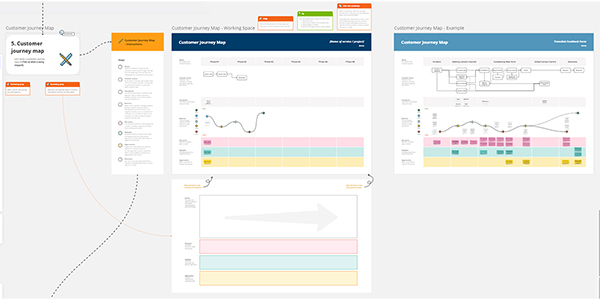Customer journey mapping can sometimes be challenging to fit into a timed workshop because the scope of the project and the complexity of the customer journey can vary widely. For example, a journey map for a simple product may be relatively straightforward and require less time than a journey map for a complex service or a long-term relationship.
The scope of the project can also impact the level of detail included in the journey map. It can sometimes be difficult to fit customer journey mapping into a single workshop without sacrificing important details or oversimplifying the process. To address this, it might be necessary to break the process into multiple sessions.
Tip
If you need more information or support to estimating and managing the efforts needed for this play. Feel free to contact us.
Collect evidence from customers
Before you use this play, you will need to make sure you have done the appropriate user research that you will base your customer journey map on. The customer journey map is meant to be supported by evidence, not assumptions.
User research is a critical step before creating a customer journey map because it provides a solid foundation of understanding about the users connected to a service. Here are some key reasons why user research is essential before creating a service blueprint:
- User research will represent users much more accurately when mapping a service, than by basing it on your team’s assumptions.
- User research can uncover pain points or areas where users may face challenges or frustrations with an existing service. Understanding these pain points early on can help you address them in your project, resulting in an improved service experience and higher user satisfaction.
- User research reduces the risk of creating inaccurate or ineffective customer journey maps, saving time, effort, and resources.
- By basing your customer journey map on user research, you can create holistic service solutions with maximum impact for your target users while also considering organisational stakeholders, systems, and processes.
There are many ways to collect the evidence you need around a target user. Desktop research and user research planning are two useful plays to get a clear plan around what you need to explore and what types of users you need to understand further. Our user interview template can also assist in gathering the information you need to get started with a customer journey map.
Synthetic users vs real users
You might have heard of something called “synthetic users” - a synthetic user is an artificial representation (also known as bots or automated scripts) of a user that is created for various purposes, such as user testing or user research.
We strongly oppose the use of synthetic users because they do not fully replicate the complexity of real human users. Real users can have diverse characteristics, behaviours, preferences, and experiences that cannot be accurately captured by synthetic users. This can lead to incomplete or biased results when conducting research, as the nuances of real human behaviour and interaction will be missed.
To be certain you have collected information that will help create true value for your customers, you will need to engage with real people from the Australian population.
Current or future state?
Are you mapping the current state or potential future state? A current state journey map gives insight into an existing service, while a future state journey map gives you the opportunity to explore and innovate future services that do not currently exist.
Mapping the current state is a great place to start if there is misalignment on what the existing process is, or if there are gaps in your knowledge about how customers experience the process. A customer journey map can be a great tool to create a common understanding of what a process is.
If the service already exists, you need to make a current state journey map before making a future state, even if your focus is on the future.
Invite your participants
Participants in this session should be made up of the project team. You’ll want to make sure when you send an invite for the session, that you clearly explain the goal, how long it’ll take, and why people’s participation will be beneficial.
Here is a calendar invitation template to give your attendees an idea of what to expect.
Subject:
Join us for a customer journey mapping session for [project name]
Meeting description:
Hi
[team name if sending a group invitation, or participant name if sending individual invitations],
As part of our ongoing work for, we'd like to get everyone together to create a customer journey map. A customer journey map is a visual representation of the user's interactions and touchpoints throughout their experience. It helps us understand their journey, identify pain points, and improve their satisfaction. In this session, we'll collaboratively work through stages to create a draft of the customer journey map, which will then be refined throughout the project. There is no preparation required on your end for this workshop.
The session will be recorded so we can refer back to any discussions for notes if required. If you do not consent to being recorded, please respond by email to let me know.
I appreciate your contribution to the session.
Kind Regards,
[Facilitator name]




